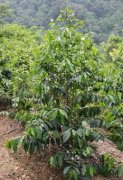Basic knowledge of boutique coffee knowledge of growing coffee

Green coffee beans are seeds of Rubiaceae plants, under which there are at least 66 species of Coffea. Two of the most commercially viable are Coffea arabica and C. canephora)。The former accounts for two-thirds of global production, while the latter, also known as Robusta, accounts for the remaining one-third. Robasta coffee and all wild coffee species have 22 chromosomes, while Arabica coffee has 44. Therefore, Arabica coffee cannot be bred with other coffee species to produce hybrid plants.
Robasta coffee is a high-yielding and pest-tolerant plant that grows up to 12 meters tall and best in warm, humid climates. Coffee made from Robasta beans has a fairly substantial, relatively strong, earthy taste and a high caffeine content of 2.4 - 2.8% by weight. Although there are many suppliers selling robasta coffee, this coffee bean does not produce the highest quality coffee.
Arabica coffee originated in the Ethiopian highlands and is a medium to low yielding, rather delicate plant, growing to a height of about 5 - 6 meters, but coffee trees cultivated for commercial purposes are pruned to 1.5 - 2 meters tall. They require a temperate climate and considerable care during their growth. Coffee made from Arabica beans has a strong, complex aroma reminiscent of flowers, fruit, honey, chocolate, caramel or toast; it contains no more than 1.5% caffeine by weight. Arabica coffee costs more than its stronger, coarser cousins because of its superior quality and flavor.
A good rain will trigger the flowering of Arabica coffee trees. After 210 days, red or yellow berries appear. Each berry contains two rectangular seeds, known as coffee beans. Since both flowers and fruits are present on the same branch, the forager's index finger and thumb are the best tools for gathering ripe berries. Grabbing the fruit off a whole branch with the palm of your hand or using automatic harvesting machines failed to distinguish between ripe and green berries.
Factors that determine the final quality of coffee beans depend on the genes of the plant, the soil in which it is grown, and the climate of the local area, including water level height, rainfall and sunlight, and daily temperature changes. These agricultural and geological considerations create many flavor differences between beans as they are roasted; suppliers mix them to create the special blends sold on the market.
Important Notice :
前街咖啡 FrontStreet Coffee has moved to new addredd:
FrontStreet Coffee Address: 315,Donghua East Road,GuangZhou
Tel:020 38364473
- Prev

Fine Coffee Science espresso espresso is the essence of coffee
In terms of pure sensory entertainment, there are few experiences in daily life that can be comparable to a good cup of coffee. The charming fragrance of a cup of hot, smoking coffee just brewed from freshly roasted beans can pull sleeping people out of bed and lead passers-by into the cafe. There are millions of people around the world who are not caused by caffeine in their coffee for a while.
- Next

General knowledge of boutique coffee trees about coffee flowers and fruits
The coffee tree is an evergreen tree with small white flowers and green fruit that does not turn red until it is ripe. A normal coffee tree can usually grow to a height of 5 to 10 meters, but bean farmers often prune it to less than 2 meters for harvest convenience. After flowering, there are many dark green oval fruits, and the mature fruits change from dark green to bright red, due to the color and cherry.
Related
- Beginners will see the "Coffee pull flower" guide!
- What is the difference between ice blog purified milk and ordinary milk coffee?
- Why is the Philippines the largest producer of crops in Liberia?
- For coffee extraction, should the fine powder be retained?
- How does extracted espresso fill pressed powder? How much strength does it take to press the powder?
- How to make jasmine cold extract coffee? Is the jasmine + latte good?
- Will this little toy really make the coffee taste better? How does Lily Drip affect coffee extraction?
- Will the action of slapping the filter cup also affect coffee extraction?
- What's the difference between powder-to-water ratio and powder-to-liquid ratio?
- What is the Ethiopian local species? What does it have to do with Heirloom native species?

